
Simple Soil Moisture Sensor - Arduino Project

This is a simple Arduino project for a soil moisture sensor that will light up an LED at a certain moisture level. It uses the Arduino Duemilanove microcontroller.
This project employs a soil moisture sensor to monitor the moisture content of the soil and activate an LED indicator when the moisture level drops below a predefined threshold. The soil moisture sensor typically consists of two probes that measure the resistance of the soil; drier soil has higher resistance, while wetter soil has lower resistance.
The Arduino Duemilanove microcontroller serves as the central processing unit for this project. It reads the analog output from the soil moisture sensor and determines the moisture level. The microcontroller is programmed using the Arduino IDE, which allows for easy coding and uploading of the program to the board.
The circuit consists of the following components:
1. **Arduino Duemilanove** - The microcontroller that processes the sensor input and controls the LED output.
2. **Soil Moisture Sensor** - This sensor has two metal probes that detect the moisture level in the soil. The analog output pin of the sensor is connected to one of the analog input pins on the Arduino.
3. **LED** - An LED is connected to a digital output pin on the Arduino through a current-limiting resistor to prevent excessive current flow. The LED will illuminate when the moisture level is below the set threshold, indicating that the soil is dry and requires watering.
4. **Resistor** - A resistor is used in series with the LED to limit the current to a safe level, typically around 220Ω to 1kΩ depending on the LED specifications.
5. **Power Supply** - The Arduino can be powered via USB or an external power source, depending on the project requirements.
The program logic involves continuously reading the moisture level from the sensor and comparing it to a predefined threshold value. If the moisture level is below this threshold, the Arduino activates the LED, signaling the need for watering. Conversely, when the moisture level is adequate, the LED remains off.
This simple yet effective project can be expanded by integrating additional features such as an LCD display to show real-time moisture levels, or a relay module to control an automatic watering system.This is a simple arduino project for a soil moisture sensor that will light up a LED at a certain moisture level. It uses Arduino Duemilanove microcontroll.. 🔗 External reference
This project employs a soil moisture sensor to monitor the moisture content of the soil and activate an LED indicator when the moisture level drops below a predefined threshold. The soil moisture sensor typically consists of two probes that measure the resistance of the soil; drier soil has higher resistance, while wetter soil has lower resistance.
The Arduino Duemilanove microcontroller serves as the central processing unit for this project. It reads the analog output from the soil moisture sensor and determines the moisture level. The microcontroller is programmed using the Arduino IDE, which allows for easy coding and uploading of the program to the board.
The circuit consists of the following components:
1. **Arduino Duemilanove** - The microcontroller that processes the sensor input and controls the LED output.
2. **Soil Moisture Sensor** - This sensor has two metal probes that detect the moisture level in the soil. The analog output pin of the sensor is connected to one of the analog input pins on the Arduino.
3. **LED** - An LED is connected to a digital output pin on the Arduino through a current-limiting resistor to prevent excessive current flow. The LED will illuminate when the moisture level is below the set threshold, indicating that the soil is dry and requires watering.
4. **Resistor** - A resistor is used in series with the LED to limit the current to a safe level, typically around 220Ω to 1kΩ depending on the LED specifications.
5. **Power Supply** - The Arduino can be powered via USB or an external power source, depending on the project requirements.
The program logic involves continuously reading the moisture level from the sensor and comparing it to a predefined threshold value. If the moisture level is below this threshold, the Arduino activates the LED, signaling the need for watering. Conversely, when the moisture level is adequate, the LED remains off.
This simple yet effective project can be expanded by integrating additional features such as an LCD display to show real-time moisture levels, or a relay module to control an automatic watering system.This is a simple arduino project for a soil moisture sensor that will light up a LED at a certain moisture level. It uses Arduino Duemilanove microcontroll.. 🔗 External reference





